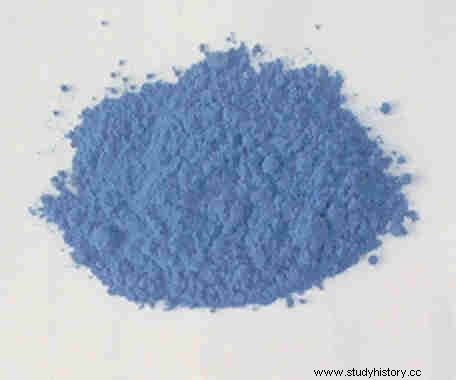Throughout the history of mankind, the color blue has been one of the most valued, identified for this reason with royalty and divinity, due to the difficulty of obtaining it.
Blue pigments have been used since ancient times, but later than others such as red, black, brown or ochre, which are easier to find in nature and are already used in Paleolithic art.
Thus, in Europe it was obtained from isatide (also known as pastel grass ), which provided an indigo dye. In Asia and Africa from indigo (indigofera tinctoria ), a shrub whose name also alludes to the variety of blue it provides.
But the most valued blue pigment came from minerals such as lapis lazuli, scarce and rare, and therefore very expensive. The largest deposits of lapis lazuli are located in the Hindukush of Afghanistan, where they are still exploited with procedures very similar to those used more than 3,000 years ago. From there it was exported throughout the ancient world, being used in jewelry and vessels in Mesopotamia and throughout the Middle East.
The Egyptians imported large amounts of lapis lazuli from those mines to obtain azurite, the powder that provided the blue pigment with which they adorned their artistic works. Its price was so high that even in medieval times it was still four times that of gold.
That is why around 3000 B.C. they looked for a way to make their own blue pigment. Little by little they perfected the technique, which consisted of grinding silica, lime, copper and an alkaline base, and heating it to a temperature of 800-900 degrees Celsius. The result obtained is considered the first synthetic pigment in history.

That is why it is called Egyptian Blue , a name that began to be used from the beginning of the 19th century to distinguish it from the rest of the bluish pigments.
The Egyptians used it to paint wood, papyrus and canvas, to color enamels, inlays and pottery. But especially in the funerary field in masks, statuettes and tomb paintings, since they believed that the color blue protected the dead from evil in the afterlife. They even colored the cloths in which the mummies were wrapped with it.
The first evidence of its use was identified by Lorelei H. Corcoran in an alabaster container, dated to the Naqada III culture of the Predynastic period (circa 3200-3000 BC), found in 1898 in the excavations of Hierakonpolis in Upper Egypt, which It also bears an inscription with the name of the Scorpion King. Today it is in the Museum of Fine Arts from Boston.
There in Hieracómpolis, one of the first antecedent nuclei of the Egyptian civilization, the oldest known Egyptian tomb with parietal painting was also found, and the first zoological collection in history.
The pigment continued to be manufactured and used throughout Antiquity, being extended by the Greeks (even in the sculptures of the Parthenon) and Romans, at least until the last years of the Western Roman Empire (c. 395 AD), when the technique fell. forgotten and the secret of the formula seemed to be lost forever. However, the infrared analysis of some pictorial works from the 16th century show signs of their use at the time.
No ancient Egyptian text makes reference to the method of production. The first testimony we have comes from the Roman architect Vitruvius, who lived in the 1st century BC. and he described it in his work De Architectura calling the pigment obtained as coeruleum (cerulean). According to Vitruvio it was produced by mixing sand, copper and natron.
In the 1930s, the archaeologist Mahmud Hamza found in the excavations of Qantir, the archaeological zone northeast of the Nile delta identified as the ancient Biblical Rameses, objects related to the production of pigment.
And more recently ceramic pots with remains of Egyptian blue appeared. in the context of a large copper smelting, glass manufacturing and earthenware production industry, suggesting that Qantir may have been an important center for producing the pigment.
The ancient Egyptians not only managed to industrially produce a color that was one of the most difficult and expensive to obtain, but the technology used for it preceded that of glass manufacturing by at least 1,500 years.
